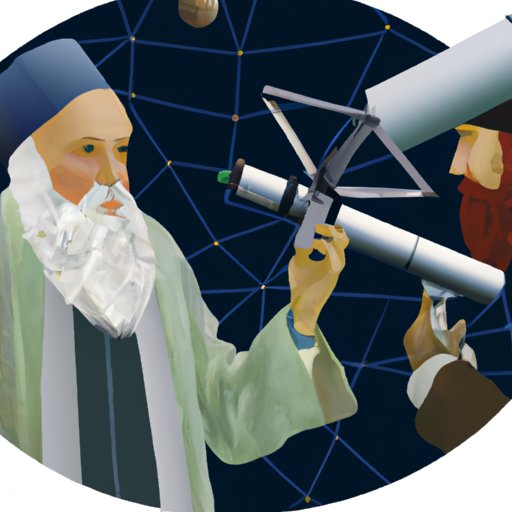Introduction
Observations in science refer to the process of collecting data through direct or indirect means. This data is then used to form hypotheses and theories that explain natural phenomena. Observations can be made with the naked eye, through instruments such as microscopes or telescopes, or through technological tools such as satellites. The purpose of this article is to explore the role of observations in science and how these observations are used to gather data and form scientific theories.

Exploring the Role of Observations in Science
The importance of making observations in science cannot be overstated. According to the scientific method, observations are the first step in the process of forming a hypothesis or theory. By observing natural phenomena, scientists can gain insight into the underlying causes of these phenomena. This understanding can then be used to develop theories that explain the observed phenomena.
Observations can also be used to test existing theories. For example, if a scientist has a hypothesis about the behavior of a certain species of bird, they can observe the birds in their natural environment to see if the hypothesis is correct. If the observations do not match the hypothesis, the scientist can modify the hypothesis or discard it altogether. This process of testing hypotheses through observations is essential to the advancement of science.
A Beginner’s Guide to Making Scientific Observations
Making accurate scientific observations is not as simple as just looking at an object or phenomenon. There are several steps involved in making reliable observations. First, the observer must decide what type of data they are looking for and what methods they will use to collect this data. Then, the observer must record their observations accurately, paying attention to details such as color, texture, size, and other characteristics of the object or phenomenon being observed. Finally, the observer must analyze their results and draw conclusions based on their observations.
There are several different types of observations that scientists can make. These include qualitative observations, which involve describing the physical characteristics of an object or phenomenon; quantitative observations, which involve measuring the properties of an object or phenomenon; and comparative observations, which involve comparing two or more similar objects or phenomena. Each type of observation has its own set of advantages and disadvantages, and scientists must choose the type of observation that best suits their research needs.

The Power of Observations: How Scientists Gather Data
Once scientists have made their observations, they must then use those observations to gather data. This data-gathering process involves analyzing the observations and interpreting them in order to draw conclusions about the object or phenomenon being studied. This process can be done manually, by writing down the observations and analyzing them later, or it can be done using technology such as computers or specialized software.
Technology has revolutionized the way scientists gather data. Computers can store large amounts of data and analyze it quickly and accurately. Specialized software can be used to visualize data and create models that help scientists understand complex phenomena. In addition, satellites and other technologies can be used to observe objects and phenomena from a distance, allowing scientists to gather data without having to be physically present.
Historical Examples of Important Scientific Observations
Throughout history, there have been many examples of important scientific observations that have advanced our understanding of the world. One of the most famous examples is Galileo’s observations of the moons of Jupiter. By observing the motion of these moons, Galileo was able to prove that the Earth was not the center of the universe. His observations were instrumental in the development of modern astronomy.
Another famous example is Darwin’s observations of finches in the Galapagos Islands. By observing the different types of finches on the islands, Darwin was able to formulate his theory of evolution by natural selection. His observations provided the evidence necessary to support his theory, which has since become one of the most important theories in biology.

The Benefits of Making Accurate Scientific Observations
Accurate scientific observations are essential for the advancement of science. By gathering accurate data, scientists can better understand the natural world and develop more accurate theories. Accurate observations also allow scientists to make more informed decisions when planning experiments or conducting research. This increased accuracy can lead to more successful experiments and more reliable results.
Analyzing the Impact of Observation-Based Science on Society
Observation-based science has had both positive and negative impacts on society. On the positive side, scientific observations have allowed us to make advances in medicine, technology, and other fields that benefit humanity. For example, observational studies have helped scientists understand the causes of diseases and develop treatments that can save lives. They have also enabled us to explore the universe and develop new technologies that improve our quality of life.
On the other hand, observational studies can also have negative impacts on society. For example, if observations are misinterpreted or inaccurate, they can lead to incorrect theories and misguided policies. This can lead to unnecessary suffering and harm, especially if the wrong decisions are made based on faulty data.
Conclusion
In conclusion, observations in science play a vital role in the formation of scientific theories and the advancement of knowledge. Accurate observations are essential for the collection of reliable data, which can then be used to develop accurate theories and make informed decisions. Historical examples such as Galileo’s observations of the moons of Jupiter and Darwin’s observations of finches in the Galapagos Islands demonstrate the power of observations in advancing our understanding of the world. Finally, observation-based science can have both positive and negative impacts on society, depending on how the data is interpreted and used.
(Note: Is this article not meeting your expectations? Do you have knowledge or insights to share? Unlock new opportunities and expand your reach by joining our authors team. Click Registration to join us and share your expertise with our readers.)
